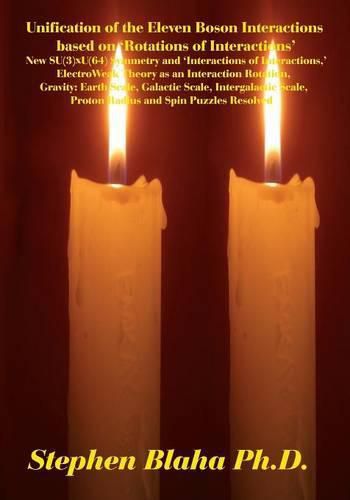Readings Newsletter
Become a Readings Member to make your shopping experience even easier.
Sign in or sign up for free!
You’re not far away from qualifying for FREE standard shipping within Australia
You’ve qualified for FREE standard shipping within Australia
The cart is loading…






This book is a supplement to Unification of the Seven Boson Interactions based on the Riemann-Christoffel Curvature Tensor ... (I). Together these works provide a unified picture of the boson sector of The Theory of Everything: vector bosons, gravitation and Higgs bosons. The boson sector unification is based on the Riemann-Christoffel tensor, which must include all interactions in its description of our curved space-time. The boson lagrangian part of The Theory of Everything is constructed from the Riemann-Christoffel tensor in a manner similar to the construction of the Theory of Gravity. In I we constructed a unified theory for the seven necessarily known interactions required by experimental data. In this book we add four interactions that would also seem to be needed: a gravitational vector spinor interaction, an SU(2) Dark Weak interaction a U(1) Dark Weak interaction, and a 'unifying' interaction that we call the Omega-Interaction. We attribute Dark Weak interactions to Dark Matter as a natural extension of the set of particle interactions. We do not introduce a Dark Strong interaction due to the cosmological data that shows Dark Matter to be diffused in lumps throughout the universe and apparently not aggregated into stars and planets. This difference suggests that a Dark nuclear force and consequently a Dark Strong interaction does not exist. After assembling the eleven forces in the Riemann-Christoffel tensor, we note that a (broken) SU(3) by U(64) symmetry is manifest and we develop the consequences of this symmetry. We take this symmetry to be a local Yang-Mills symmetry and apply the Faddeev-Popov Mechanism to generate 'ghost' interactions. Thus we go beyond the Standard Model in two ways: interactions between interactions, and ghost interactions between interactions. We conclude by showing that the gravity potential found at solar system distances, at galactic distances, and at inter-galactic distances follow from our theory. We also show that the theory yields a linear potential and the Charmonium potential. Lastly we show the theory may explain the missing proton spin, and also the difference in proton radius found in hydrogen and muonic hydrogen.
$9.00 standard shipping within Australia
FREE standard shipping within Australia for orders over $100.00
Express & International shipping calculated at checkout
Stock availability can be subject to change without notice. We recommend calling the shop or contacting our online team to check availability of low stock items. Please see our Shopping Online page for more details.
This book is a supplement to Unification of the Seven Boson Interactions based on the Riemann-Christoffel Curvature Tensor ... (I). Together these works provide a unified picture of the boson sector of The Theory of Everything: vector bosons, gravitation and Higgs bosons. The boson sector unification is based on the Riemann-Christoffel tensor, which must include all interactions in its description of our curved space-time. The boson lagrangian part of The Theory of Everything is constructed from the Riemann-Christoffel tensor in a manner similar to the construction of the Theory of Gravity. In I we constructed a unified theory for the seven necessarily known interactions required by experimental data. In this book we add four interactions that would also seem to be needed: a gravitational vector spinor interaction, an SU(2) Dark Weak interaction a U(1) Dark Weak interaction, and a 'unifying' interaction that we call the Omega-Interaction. We attribute Dark Weak interactions to Dark Matter as a natural extension of the set of particle interactions. We do not introduce a Dark Strong interaction due to the cosmological data that shows Dark Matter to be diffused in lumps throughout the universe and apparently not aggregated into stars and planets. This difference suggests that a Dark nuclear force and consequently a Dark Strong interaction does not exist. After assembling the eleven forces in the Riemann-Christoffel tensor, we note that a (broken) SU(3) by U(64) symmetry is manifest and we develop the consequences of this symmetry. We take this symmetry to be a local Yang-Mills symmetry and apply the Faddeev-Popov Mechanism to generate 'ghost' interactions. Thus we go beyond the Standard Model in two ways: interactions between interactions, and ghost interactions between interactions. We conclude by showing that the gravity potential found at solar system distances, at galactic distances, and at inter-galactic distances follow from our theory. We also show that the theory yields a linear potential and the Charmonium potential. Lastly we show the theory may explain the missing proton spin, and also the difference in proton radius found in hydrogen and muonic hydrogen.